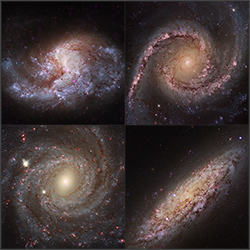Exploring New Pathways for Massive Black Hole Formation with Chandra

Vivienne Baldassare
We are happy to welcome Vivienne Baldassare as our guest blogger. Vivienne is an Assistant Professor of Physics and Astronomy at Washington State University, and led the paper that is the subject of our latest press release. Her work is mainly focused on searching for the smallest supermassive black holes in order to learn more about black hole formation and growth. Prior to her current position, she was a NASA Einstein fellow at Yale University. She earned her PhD in Astronomy & Astrophysics from the University of Michigan in 2017, and a bachelor's degree in Physics from CUNY Hunter College in 2012.
One of the biggest open questions in astrophysics is “how do massive black holes form?” Our recent research with NASA’s Chandra X-ray Observatory provides support for the theory that massive black holes can form in what astronomers call nuclear star clusters.
While big galaxies have supermassive black holes at their centers, small galaxies often have a nuclear star cluster. Nuclear star clusters are extremely dense, with millions of stars packed into a region that is tens of light years across. It was once suggested that supermassive black holes and nuclear star clusters may be mutually exclusive, with the former residing in big galaxies and the latter occurring in small galaxies. However, some galaxies (like our Milky Way!) have been found to contain both. And excitingly, some theories suggest that nuclear star clusters might be able to form massive black holes.
In my first year of graduate school, I carried out a project studying the properties of nuclear star clusters. After that, I transitioned to studying massive black holes in dwarf galaxies, but have always had a soft spot for these fascinating objects. Our new study brought these two areas together.
A recent theory published by Nick Stone and co-authors in 2017 details a specific pathway through which massive black holes could form in nuclear star clusters. They also outline specific conditions a nuclear star cluster must achieve to set this pathway in motion. First, they must have a stellar mass black hole (these form when stars die, so this is easy to achieve). Second, they must be sufficiently dense so that the small black hole repeatedly interacts with stars, captures them, and consumes them until it grows into a much larger black hole. I first talked to Nick about this theory at a conference in 2016. I was very excited to hear about this new potential formation pathway for massive black holes, and wanted to find a way to test it observationally.
We decided to test this theory by searching for X-ray emission from a sample of 108 galaxies with nuclear star clusters. X-ray emission can be a good indicator of the presence of a massive black hole. We used observations from the Chandra X-ray Observatory since we need very high resolution to definitively link the X-ray emission to the nuclear star cluster. We found that nuclear star clusters meeting the theoretical criteria for forming black holes were X-ray detected at twice the rate of those that did not. This suggests the most dense nuclear star clusters are much more likely to contain a black hole. While this does not prove that massive black holes formed via the proposed theoretical pathway, it provides an initial observational test that we can build on with future work.
Stay tuned!

